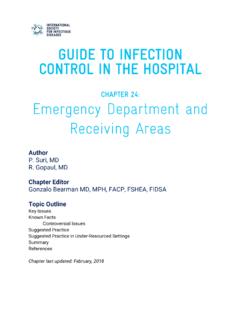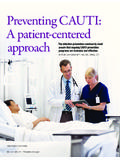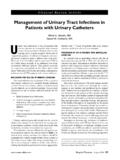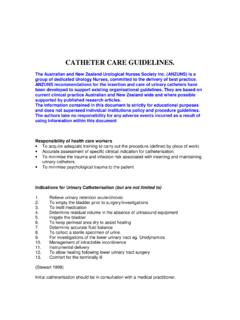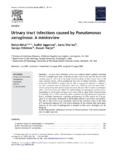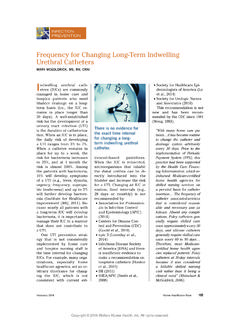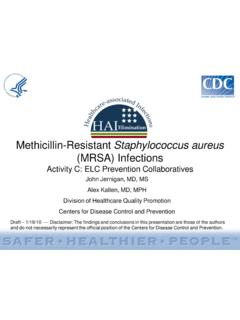Transcription of GUIDE TO INFECTION CONTROL IN THE HOSPITAL …
1 GUIDE TO INFECTION . CONTROL IN THE HOSPITAL . CHAPTER 16: Bundles in INFECTION Prevention and Safety Authors Sean Wasserman, MD. Angeliki Messina, BPharm Chapter Editor Gonzalo Bearman MD, MPH, FACP, FSHEA, FIDSA. Topic Outline Key Issues Known Facts General Principles Implementation and performance measures Specific interventions - Bundles for prevention (CLABSI, CAUTI, VAP, SSI). Suggested Practice Suggested Practice in Under-Resourced Settings Summary References Chapter last updated: February, 2018. KEY ISSUES. Care bundles are simple sets of evidence-based practices that, when implemented collectively, improve the reliability of their delivery and improve patient A number of specific bundles are available that can be implemented at healthcare facilities in resource-limited settings. These packages of care contribute to INFECTION prevention, reduce unnecessary antibiotic prescribing, and may limit the development of antibiotic resistance in healthcare facilities.
2 KNOWN FACTS. General principles The implementation of care bundles can assist in enhancing compliance to evidence-based quality process measures to improve patient care. Care bundles include a set of evidence-based measures (where possible, level 1, randomized controlled trial evidence) that when implemented together have shown to produce better outcomes and have a greater impact than that of the isolated implementation of individual Bundles also help to create reliable and consistent care systems in HOSPITAL settings since they are simple (three to five elements), clear, and In addition to creating safer patient care environments, the implementation of bundles also promotes multi-disciplinary collaboration, since they should be developed collaboratively and consensus obtained with strong clinician engagement and ,3. 1. In order for bundle implementation to be successful, each element of the bundle must be implemented collectively with complete consistency to achieve the most favorable outcomes ( all or none approach).
3 2. The effective implementation of a care bundle requires that the measures be adapted to the local setting; appropriately followed;. entrenched in the patient care culture and; recorded and evaluated to ensure compliance by all members of the healthcare team Healthcare providers are advised to follow each bundle element for every patient, always. This aims to develop and promote a positive habit- forming behavior among providers and ultimately a reliable care processes. Bundled interventions are an effective way to implement change and improve the culture of patient safety by promoting teamwork, measuring compliance and providing feedback and accountability to frontline teams and HOSPITAL leadership to improve ,6. Implementation and performance measures A multi-disciplinary approach, coupled with an institution-wide multi- modal strategy including: will-building, awareness, training, education, measurement, and feedback are required to optimally promote and sustain the implementation of care bundles in HOSPITAL settings.
4 The development of how-to guidelines, and the provision of standardized data collection tools that calculate bundle compliance are advised to ensure healthcare team members are clear on the elements of each bundle, the actions required and, how compliance is measured and tracked for feedback. Should elements of a bundle require particular supplies or products, these should be appropriately procured prior to bundle roll-out and implementation. The elements of a bundle are measured in an all or nothing manner to simplify assessment of compliance for feedback to providers and to 2. emphasize the completion of every This measurement is different from an average compliance score. A bundle compliance percentage goal should be set for the healthcare team to work toward achieving (95% bundle compliance is the recommended best practice).2. Specific interventions Bundles for the prevention of central line-associated bloodstream infections (CLABSI).
5 Central lines are used commonly in intensive care units (ICUs) and in non- ICU populations such as dialysis units, intraoperatively, and oncology patients. Most HOSPITAL -acquired bloodstream infections are associated with a central line (including peripherally-inserted central catheters, PICCs), and CLABSIs are responsible for excess mortality and morbidity, prolonged HOSPITAL stays, and increased costs. CLABSI incidence is higher in low- income countries. Implementation of central line insertion and maintenance bundles reduces the incidence of CLABSI in ICUs8 and non- ICU settings9,10, including in low-income CLABSI prevention bundles include the following components11 (minimum requirements in bold): 1. Insertion Bundle: - Maximal sterile barrier precautions (surgical mask, sterile gloves, cap, sterile gown, and large sterile drape). - Skin cleaning with alcohol-based chlorhexidine (rather than iodine).
6 12. - Avoidance of the femoral vein for central venous access in adult patients; use of subclavian rather than jugular - Dedicated staff for central line insertion, and competency training/assessment. 3. - Standardized insertion packs. - Availability of insertion guidelines (including indications for central line use) and use of checklists with trained observers. - Use of ultrasound guidance for insertion of internal jugular lines. 2. Maintenance Bundle: - Daily review of central line necessity. - Prompt removal of unnecessary lines. - Disinfection prior to manipulation of the line. - Daily chlorhexidine washes (in ICU, patients > 2 months). - Disinfect catheter hubs, ports, connectors, etc., before using the catheter. - Change dressings and disinfect site with alcohol-based chlorhexidine every 5-7 days (change earlier if soiled). - Replace administration sets within 96 hours (immediately if used for blood products or lipids).
7 - Ensure appropriate nurse-to-patient ratio in ICU (1:2 or 1:1). These activities need to be integrated in a multi-modal approach including hand hygiene, clinician and nurse education, and performance of surveillance and feedback of CLABSI rates. Bundle for the prevention of catheter-associated urinary tract infections (CAUTI). CAUTI is defined as a urinary tract INFECTION (significant bacteriuria plus symptoms and/or signs attributable to the urinary tract with no other identifiable source) in a patient with current urinary tract catheterization or who has been catheterized in the past 48 hours. It is the most common healthcare associated INFECTION worldwide,14 resulting in increased costs, HOSPITAL stays, and substantial The majority of cases are considered to be avoidable with the implementation of INFECTION prevention 4. bundles of There are a number of strategies with varying levels of evidence to prevent CAUTI before and after placement of urinary ,17 These generally include appropriate use, aseptic insertion and maintenance, early removal, and hand hygiene.
8 Recently, a large study in the United States demonstrated that a simple intervention comprising three components reduced catheter use and CAUTI rates in non-ICU acute care settings:18. 1. Avoiding the use of urinary catheters by considering alternative methods for urine collection. - Methods include: condom catheters, intermittent catheterization, use of nappies. 2. Using an aseptic technique for insertion and proper maintenance after insertion. - Following evidence-based guidelines and implementing catheter insertion policies at the institution. 3. Daily assessment of the presence and need for indwelling urinary catheters. - Indications for urinary catheterization include: - urinary retention (mechanical obstruction or neuropathic). - Need to closely monitor urine output in unstable patients. - To assist perineal wound care. The bundle above is implementable in resource-poor settings, and should be accompanied by a multimodal approach of hand hygiene, healthcare worker education, and feedback of catheter use and CAUTI rates.
9 Bundle for the prevention of ventilator associated pneumonia (VAP). VAP, defined as a new pneumonia occurring > 48 hours after endotracheal intubation, is a common and serious HOSPITAL -acquired INFECTION . It occurs in up to 20% of patients receiving mechanical ventilation19, and is associated with increased antibiotic use, length of hospitalization, and 5. healthcare costs. The mortality associated with VAP ranges from 20% to 50%, and the attributable mortality is estimated at 13%.20 It has been estimated that over half the cases of VAP may be preventable with evidence-based strategies , with an impact on The following bundle of ventilator care processes have been shown to substantially reduce VAP rates,3 and are recommended in international guidelines:21. Elevate the head of the bed to between 30 and 45 degrees. Daily sedation interruption and daily assessment of readiness to extubate.
10 Daily oral care with chlorhexidine. Prophylaxis for peptic ulcer disease. Prophylaxis for deep venous thrombosis. These interventions should be implemented together with standard precautions (hand hygiene and use of gloves when handling respiratory secretions) as well as adequate disinfection and maintenance of equipment and Other components of the VAP bundle may include: Utilization of endotracheal tubes with subglottic secretion drainage (only for patients ventilated for longer than 24 hours). Initiation of safe enteral nutrition within 24-48 hours of ICU admission Bundle for the prevention of surgical site INFECTION (SSI). SSIs are infections of the incision or organ or space that occur after surgery. SSIs complicate ~ of surgical procedures in the United States, and result in excessive healthcare In contrast, INFECTION is the most common postoperative complication in African countries, occurring in 10%.


